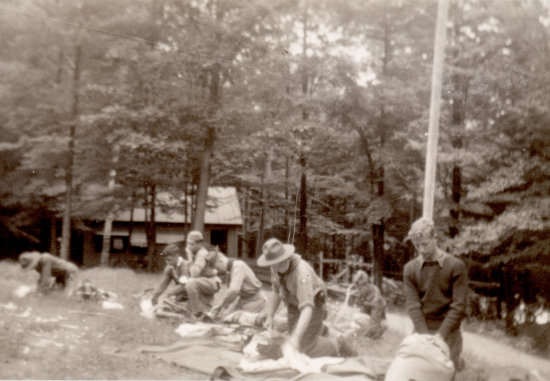1928 Season
The 1928 camp season opened on Sunday 1 July with a great deal of promise. Reservations were far ahead of any previous year, and the Scouts had many developments to look forward to, including a radio and phonograph. Fredrick Baldwin and his Camping Committee pulled stumps from the old tenting area to create a parade ground. Chief Jacot secured a donation of a new flagpole from the American Legion, where he was an active member. As part of the first week’s activities, the campers and staff raised the flagpole on the east side of the new parade ground.
A week of camp offered boys a tightly filled schedule; camp started each morning at seven, with reveille and a voluntary swim. Then, morning colors at seven-twenty, followed by a seven-thirty breakfast. The morning’s program was filled with two hours of scoutcraft, before a swimming period at eleven. Right before lunch, a staff man inspected the campers' tents for cleanliness and organization, rating each tent. After lunch, Scouts had various camp responsibilities, such as hauling water from a spring a quarter mile away. The boys carried the water to the dining hall and used it to top off the large drinking water tank. The open space that the parade ground provided meant that the Scouts could play baseball at camp, along with other games, at two o'clock. Then, as now, free swim was at four in the afternoon. Each night after dinner, the Scouts took the fleet of five boats out onto the lake, and then joined together for a campfire at eight-thirty.
Scouts occasionally broke from the schedule, weekly for an outpost trek, which usually involved a stop to play a baseball game at Camp Pioneer or Camp Sequassen. A few Scouts also hiked to the Legionaries encampment, at the new American Legion State Forest in Barkhamsted. Throughout the season, the boys constructed a swimming raft, crafted around sealed metal barrels. The Scout Mothers' Auxiliary provided a donation to get the raft started the previous fall, and when the group joined their sons for a picnic at camp, they presented $16.31 to pay for the last parts of the raft. The campers and staff finally carried the ten-foot by twelve-foot raft into the lake during the fifth week of camp. Over the summer, about a quarter of the boys in camp signed up for an addition week, making the 1928 season the most successful to that point. Seventy Scouts attended for one hundred and twenty-four boy-weeks, 163% of the 1924 record.
The image below shows Scouts packing their backpacks on the parade ground, under the flagpole. The photograph was probably taken around 1930, and shows the first dining hall, now the kitchen, in the background.
